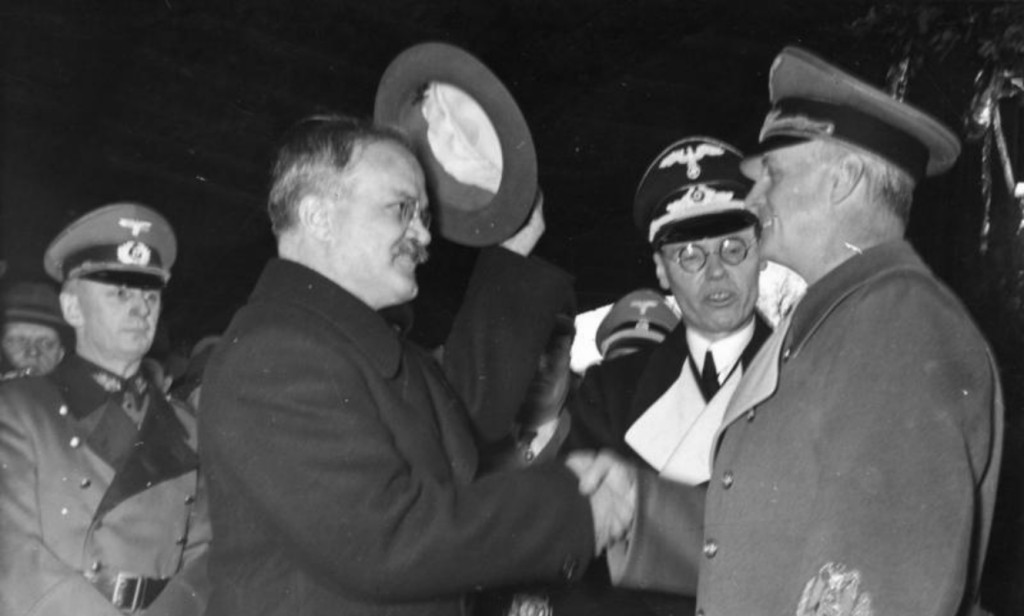Secret Pact with the Nazis? Nyet, Never Heard of It

On September 17, 1939, the Soviet military invaded Poland. In response to the Nazi German onslaught of September 1, the Polish forces had already fallen back to the southern and eastern parts of the country. The Soviet invasion eviscerated what was left of Polish defenses. By October 6, the German and Soviet forces effectively controlled the entire country. Military intervention in Eastern Europe and mendacity from Moscow were the order of the day then, as they are once again today. Thus, it may be interesting to review the battle for history over the “secret additional protocol” that sealed the fate of Poland, among other states in the region.
The carving up of Poland had been planned in August of that year. On August 23, Soviet Foreign Minister Vyacheslav Molotov and German Foreign Minister Joachim von Ribbentrop signed the Nazi–Soviet pact, a move that stunned the world and paved the way for Germany to invade Poland with impunity. While the main text of the pact was made public, a “secret additional protocol” was not publicized. This protocol said that Lithuania fell within the German sphere of influence but that the other two Baltic States and Finland were in that of the Soviets. It registered Germany’s “complete political disinterestedness” in the Romanian region of Bessarabia. Also, it declared that “in the event of a territorial and political rearrangement of the areas belonging to the Polish state,” the spheres of influence would be divided “… approximately by the line of the rivers Narew, Vistula, and San” — German to the west and Soviet to the east.
Thus did the two great totalitarian powers of the period carve up Eastern Europe. Their actions were visible for all to see, but their collusion was deeply secret. However, when the Allies overran Germany in 1945 they captured vast quantities of German records including many from the German foreign ministry. Among them was the “secret protocol.” It was leaked to a member of the defense team during the Nuremberg trials. When he mentioned the document at trial, the Soviet prosecutor objected strenuously and the document was not introduced into evidence. However, somehow the St. Louis Post Dispatch and the Manchester Guardian got copies and published them in May 1946.
The very next month, the United States and the United Kingdom agreed to cooperate on the Documents on German Foreign Policy (DGFP) project, which ultimately would last for several years and produce numerous volumes of selected documents. According to the agreement, the idea was to “forestall subsequent journalistic ventures or those of former Nazis that would be of a tendentious nature, and … most of all, demonstrate Germany’s responsibility of [sic] the outbreak of the recent war.”
Research for the first volume in the DGFP series was completed in 1947. Clearly its subject was chosen with an eye toward the Cold War, which was already starting to cast a chill over the world. The volume was to be Nazi–Soviet Relations, 1939–1941. However, Secretary of State George C. Marshall postponed the publication of the book until he had a chance to meet with Soviet representatives and urge them to bring their policy on Germany more into line with the West’s approach. When that failed, he gave the go-ahead. The book appeared in January 1948 and contained the explosive “secret protocol.” The Soviets were not amused. The Soviet response was that the book was anti-Soviet propaganda, that it reflected a discriminatory policy against the Soviet Union, that the USSR should have been given equal access to the documents, and that, in any event, the Western Allies had armed Hitler and tried to maneuver him into attacking the Soviet Union. In fact, in February 1948, the Soviet Union published its own book, Falsificators of History (in some editions it is Falsifiers), purportedly personally edited by Joseph Stalin, making this case. As for the “secret protocol” specifically, the Soviet Union publicly denied until 1989 that it ever existed. On December 23, just two days before Mikhail Gorbachev resigned as leader of the Soviet Union, he handed over to Russian President Boris Yeltsin a number of envelopes containing documents. He told Yeltsin, “I am afraid they can lead to international complications. However, it is up to you to decide.” The original Russian language text of the “secret protocol” was among these documents. Research over the coming months showed that every Soviet leader since Stalin had seen this and other key documents about Soviet policy toward Poland but they had all kept quiet. Yeltsin had the protocol declassified in 1992.
In 2008 Putin himself denounced the 1939 agreement. More recently, however, the Russian line has been that the “secret protocol” never assigned territory to Germany or to the USSR and that the Molotov–Ribbentrop Pact of which they were a part was one of the “great achievements of Soviet diplomacy.” Putin himself offered a defense of the pact at a joint news conference with German Chancellor Angela Merkel in May.
It seems, then, that Putin isn’t satisfied to deny the facts of Russian actions in Eastern Europe today; he has decided to do so about those of three quarters of a century ago, as well.
Mark Stout is a Senior Editor at War on the Rocks. He is the Director of the MA Program in Global Security Studies and the Graduate Certificate Program in Intelligence at Johns Hopkins University’s School of Arts and Sciences in Washington, D.C.
Photo credit: Bundesarchiv, Bild 183-1984-1206-523 / CC-BY-SA 3.0

